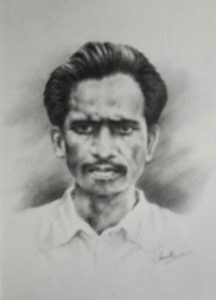
Comrade Babulal Biswakarmakar was the first leader of the Naxalbari uprising to embrace martyrdom in a gun battle with the police. On 6 September 1968 Comrade Babulal Biswakarmakar had joined a team led by Comrade Khokan Mazumdar to plan a sudden attack on the police camp in Birsinghjote. The other two members of the team were Joseph Munda and Kurhu Munda.
They had taken shelter in the home of Lalchand Biswakarmakar at Hochaimullickjote. After elaborate planning, the squad left the house on 7 September evening after dinner. It was a moonlit night and the squad branched out in groups of two – Comrades Khokan Mazumdar and Joseph Munda followed by Comrades Babulal Biswakarmakar and Kurhu Munda. The comrades were however soon warned by shouts by the village women. They realized that the police was following them.
Comrades Khokan Mazumdar and Joseph Munda hid in the nearby bamboo jungle. Comrade Babulal hid himself in a dry pond, while Kurhu hid in the tall grasses near the pond. Police surrounded the area but remained silent. Eventually the police asked the squad to surrender; but Comrade Babulal decided to engage the police in a battle so others could escape unscathed. He only had a rifle snatched from Kharibari landlord Baicharan Singh, and with that rifle he held off the entire police team for four hours (9 pm – 1 am) in a gun battle, before bullets riddled his chest. Police could find his body only in the morning, with 6 bullet injuries in his body.
The police searched in vain all morning for the other comrades, and then brought Comrade Babulal’s body to the Naxalbari PS at 4 pm on 8 September, but instead of handing over his body to his family, the police cremated him.
Villagers of the region erupted in angry protest against Comrade Babulal’s killing. On 20 September, at Prasadujote in Naxalbari, a peasant mass meeting and rally was held, which the revolutionary students of North Bengal University had helped to organize. Groups of peasants from Naxalbari, Kharibari and Phansidewa joined this program.
On 19 September 1968, Deshabrati wrote about Comrade Babulal: “At 9 pm on the night of 7 September, police surrounded a revolutionary squad including Comrade Babulal. He then used his skill in guerilla warfare and engaged the police in battle to help the other comrades escape. He crawled on his hands and knees, firing on the police from strategic angles. As a result, the police informer as well as some policemen were injured. Then the police fired rapidly at him in retaliation. The battle continued from 9 pm at night to 1 am. The young revolutionary embraced martyrdom with the gun in his hand.”
Comrade Babulal was born in 1937 in a landless poor peasant family in Malancha village of Dinajpur district. In the mid 1940s, the region became a storm centre of the Tebhaga agitation with sharecroppers demanding two-thirds of the produce, leaving one-third for the landowner. On the night of 20 February 1947 the police had attacked Khanpur village in Dinajpur to arrest the agitation leaders but the people resisted and as many as 21 peasants, including the legendary Jashoda Ma, who had blown her conch shell to alert the people about the police, were killed in police firing. Babulal’s family was in the thick of this historic agitation, his elder brothers Harendra, Prasanna and Raghunath barely managing to escape getting killed in the February 20 Khanpur massacre.
In 1950 Babulal’s family was evicted from Dinajpur. They moved to Hochaimullickjote at Hatighisa village of Darjeeling. This was a family of Tebhaga organisers and activists, and they brought the spirit and experience of the historic Tebhaga agitation from Dinajpur to Darjeeling. On February 7, 1953 a militant struggle ensued against landlord Sherket Singh who used to charge usurious rates for whatever amounts he lent. For 15 year-old Babulal, this was his first direct experience of a militant peasant resistance. He suffered injuries and was put in prison, coming out on bail only after several months. He had to wait till 1956, when he turned 18, to be recognised as a full time activist of the Communist Party. He then plunged headlong into organising peasants as well as tea garden workers in militant struggles for their rights. During the India-China war of 1962 Babulal was again arrested along with many other revolutionary communists in the district. In 1964 he joined the CPI(M) and within the CPI(M) he began to fight for strengthening the revolutionary wing under the leadership of Comrade Charu Mazumdar. After the peasant uprising of Naxalbari, Babulal was again sent to jail, this time in a solitary cell in Kurseong. Out on bail in 1968, he resumed his role as a leader of the armed peasant revolutionary war. He was only 31 when he laid down his life in the first heroic gun battle of Naxalbari.
